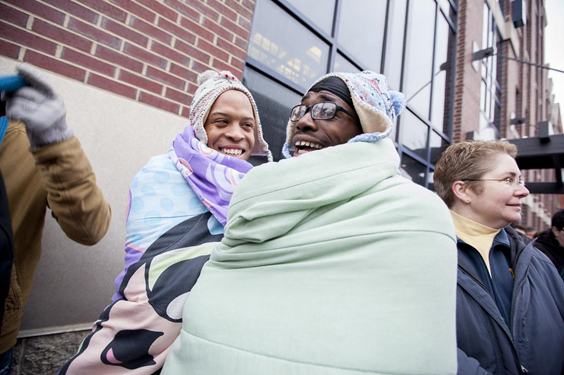11.4: Sexuality in Early Adulthood
- Page ID
- 167224

Sexual Responsiveness Peak
Men and women tend to reach their peak of sexual responsiveness at different ages and among men and women there is also variation so these milestones should serve as generalities. For men, sexual responsiveness tends to peak in the late teens and early twenties. Sexual arousal can easily occur in response to physical stimulation or fantasizing. Sexual responsiveness begins a slow decline in the late twenties and into the thirties. Through time, a man may require more intense stimulation in order to become aroused. Women often find that they become more sexually responsive throughout their 20s and 30s and may peak in the late 30s or early 40s. This may be due to greater self-confidence and reduced inhibitions about sexuality.
Hooking Up
United States demographic changes have significantly affected the romantic relationships among emerging and early adults. As previously described, the age for puberty has declined, while the times for one’s first marriage and first child have been pushed to older ages. This results in a “historically unprecedented time gap where young adults are physiologically able to reproduce, but not psychologically or socially ready to settle down and begin a family and child rearing,” (Garcia, Reiber, Massey, & Merriwether, 2012, p. 172). Consequently, according to Bogle (2007, 2008) traditional forms of dating have shifted to more casual hookups that involve uncommitted sexual encounters. Even though most research on hooking up involves college students, 70% of sexually active 12- 21 year olds reported having had uncommitted sex during the past year (Grello, Welsh, Harper, & Dickson, 2003). A review of the literature suggests that these encounters are becoming increasingly normative among adolescents and young adults in North America, representing a marked shift in openness and acceptance of uncommitted sex. Additionally, Manning, Giordano and Longmore (2006) found that 61% of sexually active seventh, ninth, and eleventh graders reported being involved in a sexual encounter outside of a dating relationship.
Friends with Benefits: Hookups are different from the relationships that involve continued mutual exchange. These relationships are often referred to as Friends with Benefits (FWB) or “Booty Calls.” These relationships involve friends having casual sex without commitment. Hookups do not need to include a friendship relationship but they may. Bisson and Levine (2009) found that 60% of 125 undergraduates reported a FWB relationship. Research also found that the common concern was that sex might complicate friendships by bringing forth unreciprocated desires for romantic commitment, and ironically that these relationships were desirable because they incorporated trust and comfort while avoiding romantic commitment. However, participants indicated that people in FWB relationships most often avoided explicit relational negotiation.

Hooking up Gender Differences: When asked about their motivation for hooking up, both males and females indicated physical gratification, emotional gratification, and a desire to initiate a romantic relationship as reasons (Garcia & Reiber, 2008). Although people of different gender are more similar than different in their sexual behaviors, a consistent finding among the research is that males demonstrate a greater permissiveness to casual sex (Oliver & Hyde, 1993). In another study involving 16,288 individuals across 52 nations, males reported a greater desire of sexual partner variety than females, regardless of relationship status or sexual orientation (Schmitt et al., 2003). This difference can be attributed to gender role expectations for both males and females regarding sexual promiscuity. Additionally, the risks of sexual behavior are higher for females and include unplanned pregnancy, increased sexually transmitted diseases, and susceptibility to sexual violence (Garcia et al., 2012).
Although hooking up relationships have become normalized for emerging adults, some research indicates that the majority of people would prefer a more traditional romantic relationship (Garcia et al., 2012). Additionally, Owen and Fincham (2011) surveyed 500 college students with experience with hookups, and 65% of women and 45% of men reported that they hoped their hookup encounter would turn into a committed relationship. Further, 51% of women and 42% of men reported that they tried to discuss the possibility of starting a relationship with their hookup partner.
Online Dating
The ways people are finding love has changed with the advent of the Internet. Nearly 50 million Americans have tried an online dating website or mobile app (Bryant & Sheldon, 2017). Online dating has also increased dramatically among those of 18 to 24. Today, one in five emerging adults report using a mobile dating app, while in 2013 only 5% did, and 27% report having used online dating, almost triple the rate in 2013 (Smith & Anderson, 2016).
According to a recent survey of couples who met online versus offline (Brown, 2019), those who met online tended to have slightly different levels of education, and political views from their partners, but, the biggest difference was that they were much more likely to come from different racial and ethnic backgrounds. This is not surprising as the average age of the couples who met online was 36, while the average age of a couple who met offline was 51. Young adults are more likely to be in a relationship with people who are different from them, regardless of how they met.
To evaluate what individuals are looking for online, Menkin, Robles, Wiley and Gonzaga (2015) reviewed data from an eHarmony.com relationship questionnaire completed by a cross-sectional representation of 5,434 new users. Their results indicated that users consistently valued communication and characteristics, such as personality and kindness over sexual attraction. Females valued communication over sexual attraction, even more when compared to males, and older users rated sexual attraction as less important than younger users. Alterovitz and Mendelsohn (2011) analyzed 600 Internet personal ads across the lifespan and found that men sought physical attractiveness and offered status related information more than women, while women were more selective than men and sought status more than men. These findings were consistent with previous research on gender differences regarding the importance of physical/sexual attraction.

Cohabitation
In American society, as well as in a number of other cultures, cohabitation has become increasingly commonplace (Gurrentz, 2018). For many emerging adults, cohabitation has become more commonplace than marriage. While marriage is still a more common living arrangement for those 25-34, cohabitation has increased, while marriage has declined. Gurrentz also found that cohabitation varies by socioeconomic status. Those who are married tend to have higher levels of education, and thus higher earnings, or earning potential.
Three explanations have been given for the rise of cohabitation in Western cultures. The first notes that the increase in individualism and secularism, and the resulting decline in religious observance, has led to greater acceptance and adoption of cohabitation (Lesthaeghe & Surkyn, 1988). Moreover, the more people view cohabitating couples, the more normal this relationship becomes, and the more couples who will then cohabitate. Thus, cohabitation is both a cause and the effect of greater cohabitation. A second explanation focuses on economic changes. The growth of industry and the modernization of many cultures has improved women’s social status, leading to greater gender equality and sexual freedom, with marriage no longer being the only long-term relationship option (Bumpass, 1990). A final explanation suggests that the change in employment requirements, with many jobs now requiring more advanced education, has led to a competition between marriage and pursuing post-secondary education (Yu & Xie, 2015). This might account for the increase in the age of first marriage in many nations. Taken together, the greater acceptance of premarital sex, and the economic and educational changes has led to a transition in relationships. Overall, cohabitation may become a step in the courtship process or may, for some, replace marriage altogether.
Similar increases in cohabitation have also occurred in other industrialized countries. For example, rates are high in Great Britain, Australia, Sweden, Denmark, and Finland. In fact, more children in Sweden are born to cohabiting couples than to married couples. The lowest rates of cohabitation in industrialized countries are in Ireland, Italy, and Japan (Benokraitis, 2005).
Similar to other nations, young people in the Philippines are more likely to delay marriage, to cohabitate, and to engage in premarital sex as compared to previous generations (Williams, Kabamalan, & Ogena, 2007). Despite these changes, many young people are still not in favor of these practices. Moreover, there is still a persistence of traditional gender norms as there are stark differences in the acceptance of sexual behavior out of wedlock for men and women in Philippine society. Young men are given greater freedom. In China, young adults are cohabitating in higher numbers than in the past (Yu & Xie, 2015). Unlike many Western cultures, in China, adults with higher rather than lower levels of education are more likely to cohabitate. Yu and Xie (2015) suggest this may be due to seeing cohabitation as being a more “innovative” behavior and that those who are more highly educated may have had more exposure to Western culture.
Marriage
Marriage Worldwide: Cohen (2013) reviewed data assessing most of the world’s countries and found that marriage has declined universally during the last several decades. This decline has occurred in most nations, however, the countries with the biggest drops in marriage were France, Italy, Germany, Japan and the U.S. Cohen states that the decline is not only due to individuals delaying marriage, but also because of high rates of non- marital cohabitation. Delayed or reduced marriage is associated with higher income and lower fertility rates that are reflected worldwide.
Marriage in the United States: In 1960, 72% of adults age 18 or older were married, in 2010 this had dropped to barely half (Wang & Taylor, 2011). At the same time, the age of first marriage has been increasing for both men and women. In 1960, the average age for first marriage was 20 for women and 23 for men. By 2010 this had increased to 26.5 for women and nearly 29 for men. Many of the explanations for increases in singlehood and cohabitation previously given can also account for the drop and delay in marriage.

Marriage Equality: On June 26, 2015, the United States Supreme Court ruled that the Constitution guarantees marriage equality. The decision indicated that limiting marriage to only heterosexual couples violated the 14th amendment’s guarantee of equal protection under the law. This ruling occurred 11 years after same-sex marriage was first made legal in Massachusetts, and at the time of the high court decision, 36 states and the District of Columbia had legalized same sex marriage. Worldwide, 29 countries currently have national laws allowing gays and lesbians to marry (Pew Research Center, 2019). These countries are located mostly in Europe and the Americas.
Cultural Influences on Marriage: Many cultures have both explicit and unstated rules that specify who is an appropriate mate. Consequently, mate selection is not completely left to the individual. Rules of endogamy indicate the groups we should marry within and those we should not marry in (Witt, 2009). For example, many cultures specify that people marry within their own race, social class, age group, or religion. Endogamy reinforces the cohesiveness of the group. Additionally, these rules encourage homogamy or marriage between people who share social characteristics. The majority of marriages in the U. S. are homogamous with respect to race, social class, age and to a lesser extent, religion. Homogamy is also seen in couples with similar personalities and interests.
Intimate Partner Abuse
Violence in romantic relationships is a significant concern for relationships throughout the lifespan. Statistically women aged 18 to 34 generally experience the highest rates of intimate partner violence. According to the most recent Violence Policy Center (2018) study, more than 1,800 women were murdered by men in 2016. The study found that nationwide, 93% of women killed by men were murdered by someone they knew, and guns were the most common weapon used. The national rate of women murdered by men in single victim/single offender incidents dropped 24%, from 1.57 per 100,000 in 1996 to 1.20 per 100,000 in 2016. However, since reaching a low of 1.08 per 100,000 women in 2014, the 2016 rate increased 11%.
Intimate partner violence is often divided into situational couple violence, which is the violence that results when heated conflict escalates, and intimate terrorism, in which one partner consistently uses fear and violence to dominate the other (Bosson, et al., 2019). Men and women equally use and experience situational couple violence, while men are more likely to use intimate terrorism than are women. Additionally, female victims of intimate partner violence experience different patterns of violence, such as rape, severe physical violence, and stalking than male victims, who most often experienced more slapping, shoving, and pushing.
If you need help: Call The National Domestic Violence Hotline 1-800-799-SAFE (7233) or go to The Hotline.org.



